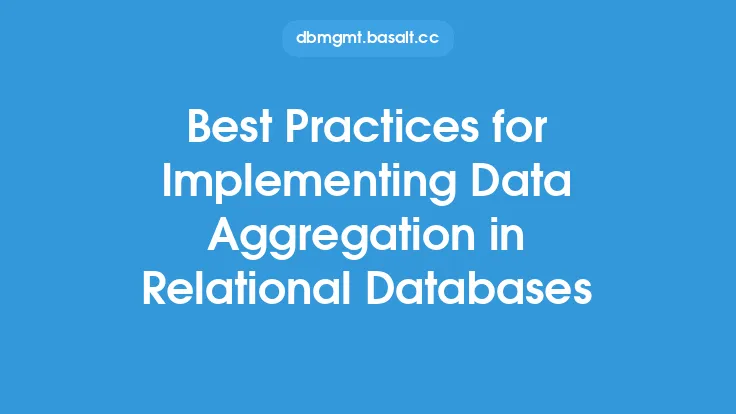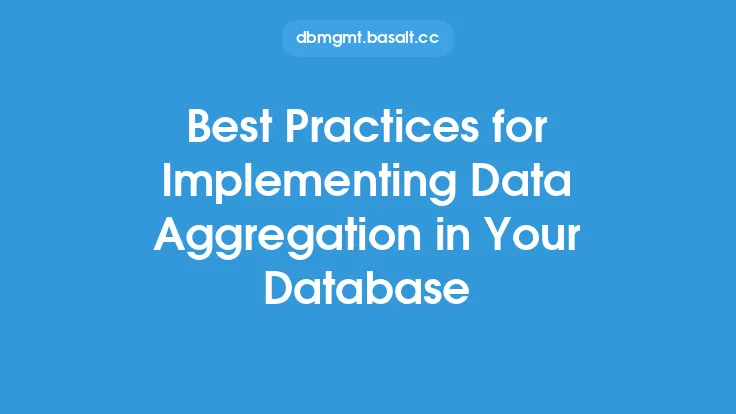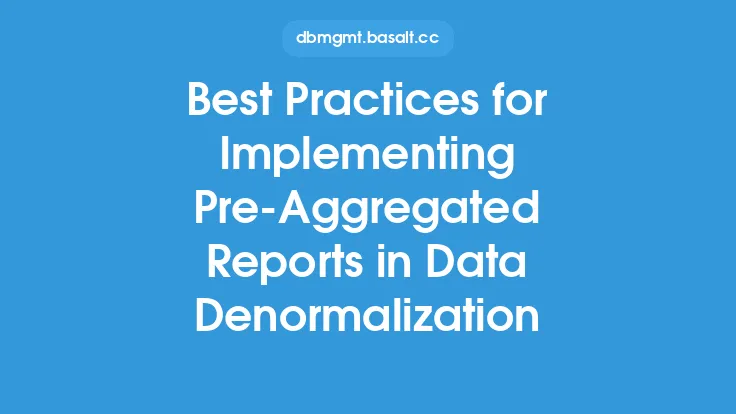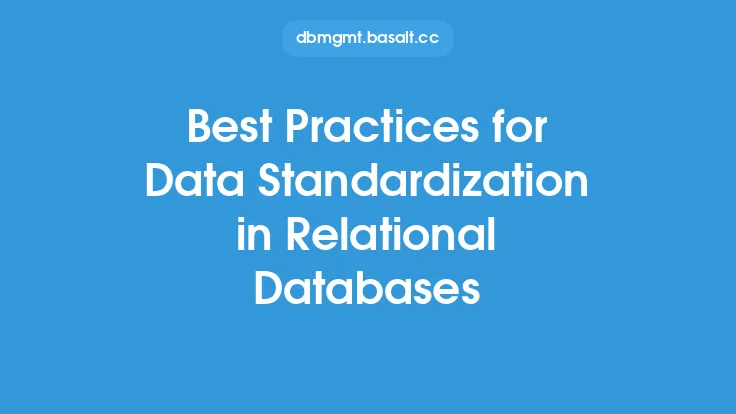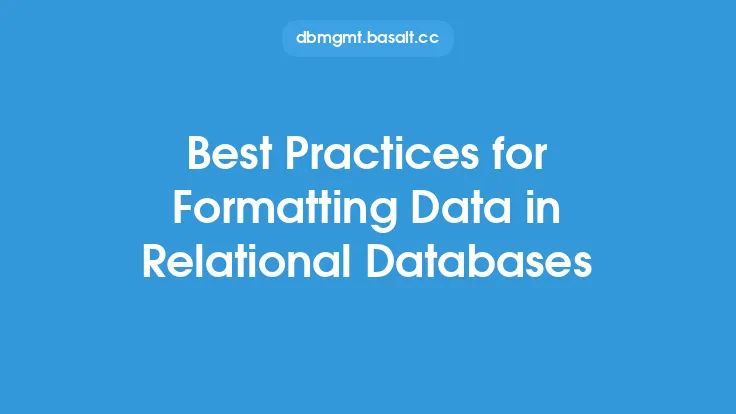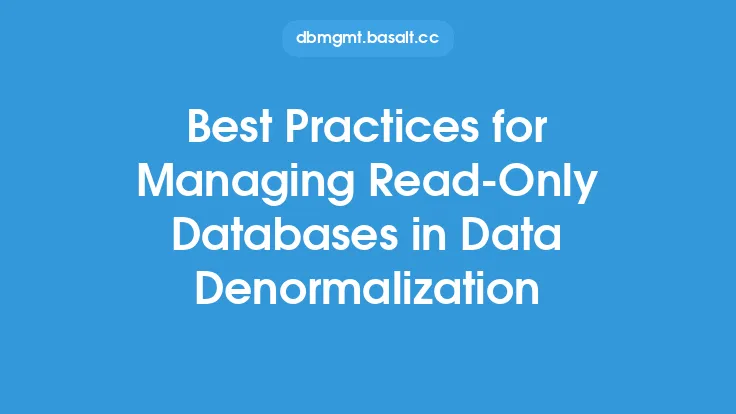Implementing data encryption in databases is a critical aspect of database security, as it protects sensitive data from unauthorized access and ensures the confidentiality, integrity, and availability of the data. Data encryption is the process of converting plaintext data into unreadable ciphertext, making it inaccessible to anyone without the decryption key. In this article, we will discuss the best practices for implementing data encryption in databases, focusing on the technical and practical aspects of encryption.
Introduction to Data Encryption in Databases
Data encryption in databases can be implemented at various levels, including data at rest, data in transit, and data in use. Data at rest refers to the data stored in the database, while data in transit refers to the data being transmitted between the database and the application or user. Data in use refers to the data being processed by the database. Each level of encryption requires a different approach and technique. For example, data at rest can be encrypted using symmetric key encryption, such as AES, while data in transit can be encrypted using asymmetric key encryption, such as SSL/TLS.
Choosing the Right Encryption Algorithm
Choosing the right encryption algorithm is crucial for effective data encryption. The most commonly used encryption algorithms for database encryption are AES (Advanced Encryption Standard) and RSA (Rivest-Shamir-Adleman). AES is a symmetric key encryption algorithm that is widely used for encrypting data at rest, while RSA is an asymmetric key encryption algorithm that is commonly used for encrypting data in transit. Other encryption algorithms, such as Blowfish and Twofish, can also be used, but AES and RSA are the most widely accepted and used. When choosing an encryption algorithm, consider factors such as key size, block size, and performance.
Key Management Best Practices
Key management is a critical aspect of data encryption, as it involves generating, distributing, and managing encryption keys. Best practices for key management include generating keys randomly, storing keys securely, and rotating keys regularly. Keys should be generated using a secure random number generator and should be stored in a secure key store, such as a hardware security module (HSM) or a trusted platform module (TPM). Keys should be rotated regularly to minimize the impact of a key compromise. Additionally, keys should be backed up and stored securely to ensure business continuity in case of a key loss.
Implementing Encryption in the Database
Implementing encryption in the database involves encrypting data at rest, data in transit, and data in use. Data at rest can be encrypted using transparent data encryption (TDE), which encrypts data at the storage level, or using column-level encryption, which encrypts data at the column level. Data in transit can be encrypted using SSL/TLS, which encrypts data between the database and the application or user. Data in use can be encrypted using in-memory encryption, which encrypts data in the database buffer cache. When implementing encryption, consider factors such as performance, scalability, and compatibility.
Best Practices for Encrypting Data at Rest
Encrypting data at rest involves encrypting data stored in the database. Best practices for encrypting data at rest include using TDE, encrypting data at the column level, and using a secure key store. TDE encrypts data at the storage level, making it transparent to the application and user. Column-level encryption encrypts data at the column level, allowing for more granular control over encryption. A secure key store, such as an HSM or TPM, should be used to store encryption keys. Additionally, data should be encrypted using a secure encryption algorithm, such as AES, and keys should be rotated regularly.
Best Practices for Encrypting Data in Transit
Encrypting data in transit involves encrypting data transmitted between the database and the application or user. Best practices for encrypting data in transit include using SSL/TLS, using a secure protocol, and verifying the identity of the client and server. SSL/TLS encrypts data between the database and the application or user, making it secure from eavesdropping and tampering. A secure protocol, such as HTTPS, should be used to transmit data. The identity of the client and server should be verified using certificates and authentication protocols, such as Kerberos or RADIUS.
Performance Considerations
Implementing data encryption can impact database performance, as encryption and decryption operations can be computationally intensive. To minimize the impact on performance, consider using hardware-based encryption, such as AES-NI, which can accelerate encryption and decryption operations. Additionally, consider using parallel processing and multi-threading to improve performance. Regularly monitor database performance and adjust encryption settings as needed to ensure optimal performance.
Auditing and Compliance
Implementing data encryption is not only a security best practice but also a compliance requirement. Many regulations, such as PCI-DSS and HIPAA, require data encryption to protect sensitive data. To ensure compliance, regularly audit database encryption settings and ensure that encryption is implemented correctly. Use auditing tools and techniques, such as logging and monitoring, to detect and respond to security incidents. Additionally, ensure that encryption keys are managed securely and that access to encrypted data is controlled and audited.
Conclusion
Implementing data encryption in databases is a critical aspect of database security, as it protects sensitive data from unauthorized access and ensures the confidentiality, integrity, and availability of the data. By following best practices, such as choosing the right encryption algorithm, implementing key management, and encrypting data at rest and in transit, organizations can ensure effective data encryption and protect sensitive data. Regularly monitoring database performance, auditing and compliance, and staying up-to-date with the latest security threats and vulnerabilities are also essential for maintaining effective data encryption.
